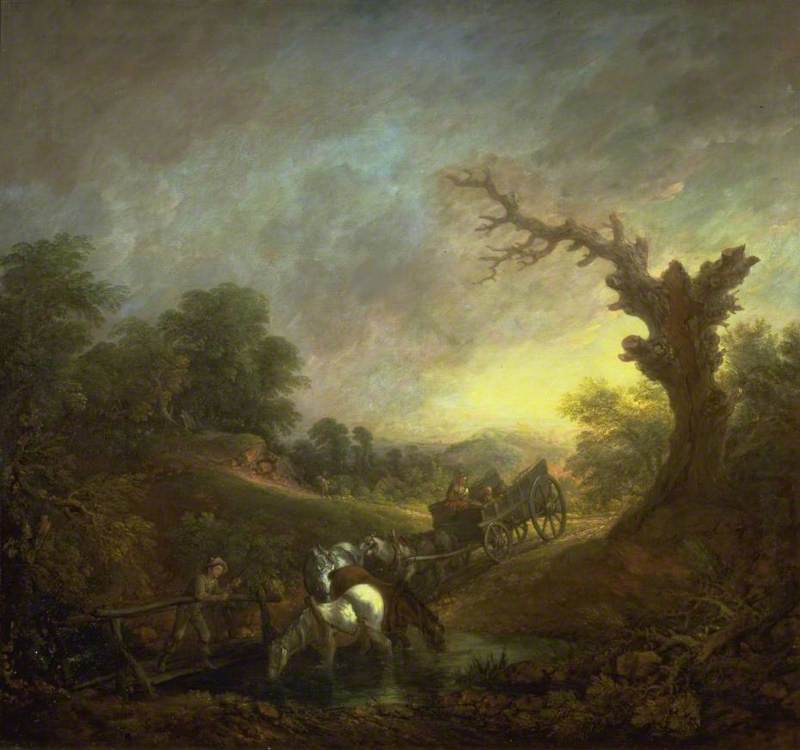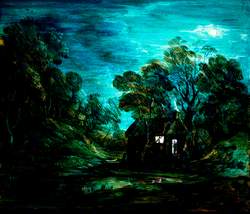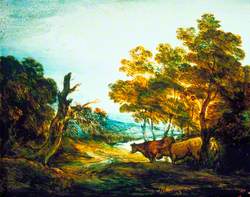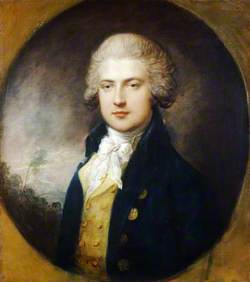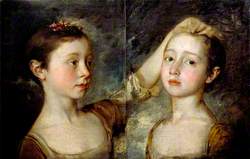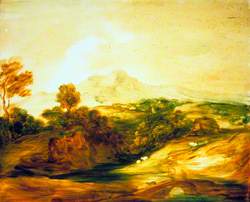How you can use this image
This image is available to be shared and re-used under the terms of the Creative Commons Attribution-NonCommercial-NoDerivatives licence (CC BY-NC-ND).
You can reproduce this image for non-commercial purposes and you are not able to change or modify it in any way.
Wherever you reproduce the image you must attribute the original creators (acknowledge the original artist(s) and the person/organisation that took the photograph of the work) and any other rights holders.
Review our guidance pages which explain how you can reuse images, how to credit an image and how to find more images in the public domain or with a Creative Commons licence available.
DownloadNotes
Add or edit a note on this artwork that only you can see. You can find notes again by going to the ‘Notes’ section of your account.
'Sunset: Carthorses Drinking at a Stream' is one of several paintings by Gainsborough on the theme of peasants going to or from market. The family here are travelling home in a country wagon and are shown in a moment of repose after the labours of the day; the drover on the footbridge halts by a stream to allow the horses to quench their thirst. The landscape is bathed in a warm, golden light and the glowing sunset adds a suitable poetic note to the tranquil scene. Gainsborough's move from his native Suffolk to the fashionable spa town of Bath in 1759 coincided with a change of style in his painting. Whereas the influence of the Dutch manner is apparent in his earlier landscapes, with their close observation of nature and ordered compositions, those painted in Bath, and subsequently in London, became more pastoral and poetic.
In addition to the more Flemish approach to landscape, Gainsborough has also borrowed something of the structure and poetry of Claude Lorraine, at the time regarded as one of the greatest Old Masters of landscape painting. The artifice or contrived nature of the composition is most apparent in its curving, almost circular design, created by the sweeping arch of the pollarded tree on the right and the downward movement of the wagon and horses towards the stream. This pronounced circular structure gives a 'peephole' effect to the composition, which offers the viewer an intimate glimpse of an enclosed and idyllic world.
Gainsborough's change in style, following his move to Bath, was probably a response to the sophisticated tastes of his new patrons there. It was also possibly aided by his seeing works by Claude and Rubens and other Old Masters in some of the nearby art collections, such as those at Wilton and Stourhead. His tendency, once in Bath, to produce nostalgic rural idylls may also have been an escape from the demands of urban life and from his flourishing but wearisome portrait practice. During this period of Gainsborough's career, he remained fascinated by landscape and made frequent sketching excursions into the surrounding countryside. However, there is something of a duality in Gainsborough's practice as a landscape painter. Although he was an avid sketcher from nature, it is reported that around this time he built model landscapes in his studio, consisting of coal, clay or sand with pieces of mirror for lakes and sprigs of broccoli to represent trees, in order to help him construct his compositions. These artificial models, created by the dim light of a candle, were used as a basis for his finished paintings – entirely imaginary landscape compositions, such as this.
Further Reading: E. K. Waterhouse, 'Gainsborough', London 1958, no. 897, reproduced pl.65 John Hayes, 'The Landscape Paintings of Thomas Gainsborough', 2 vols, London, 1982, no. 75 Amal Asfour and Paul Williamson, 'Gainsborough's Vision', Liverpool, 1999, p.163, reproduced in colour pl. 91 Diane Perkins July 2001
Title
Sunset: Carthorses Drinking at a Stream
Date
c.1760
Medium
Oil on canvas
Measurements
H 143.5 x W 153.7 cm
Accession number
N00310
Acquisition method
Presented by Robert Vernon 1847
Work type
Painting
